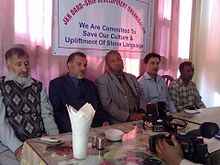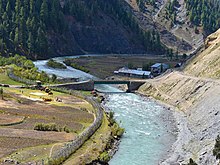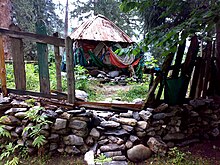Gurez
Gurez
Guráai Gurais | |
|---|---|
Tehsil | |
 View of Habba Khatoon in Gurez | |
| Coordinates: 34°38′00″N 74°50′00″E / 34.6333°N 74.8333°E | |
| Country | India |
| Union Territory | Jammu and Kashmir |
| District | Bandipora |
| Government | |
| • Vidhan Sabha Constituency | Gurez |
| • MLA | Nazir Ahmad Khan Gurezi[2] |
| • Sub-Divisional Magistrate | Dr. Mudasir Ahmad Wani, JKAS[3] |
| Elevation | 2,580 m (8,460 ft) |
| Population (2011) | |
| • Total | 37,992[1] |
| Demographics | |
| • Literacy[1] | 59.17% |
| • Sex ratio[1] | 653 ♀/ 1000 ♂ |
| Languages | |
| • Official | Kashmiri, Urdu, Hindi, Dogri, English[4][5] |
| • Spoken | Shina, Kashmiri |
| Time zone | UTC+5:30 (IST) |
| PIN | 193503 |
| Vehicle registration | JK-15 |
| Website | bandipore |
Gurez, or Gurais[6] (Guráai in the local Shina language),[7] is a valley located in the high Himalayas, about 86 kilometres (53 mi) from Bandipore and 123 kilometres (76 mi) from Srinagar, to the north of the Kashmir valley. At about 2,400 metres (8,000 ft) above sea level, the valley is surrounded by snow-capped mountains. The fauna include the Himalayan brown bear and the snow leopard. The Kishanganga River flows through the valley.[8]
The valley lies near the Line of Control, which separates it from the Astore and Neelum districts of Pakistan-administered Kashmir. It is very close to the Burzil Pass, which leads into Astore, and the inhabitants are ethnic Dards/Shins. They speak the Shina language and have the same styles of dress and culture as their kinsmen in Pakistani-administered Gilgit-Baltistan.[9]
Dawar is the central township in the area. The population of the area is estimated to be about 30,000, and is scattered among fifteen villages.
Due to heavy snowfall (around 2 metres (7 ft)) and closure of Razdan Pass in winter, the valley remains cut off for six months of the year.[10]
Gurez is 143 km from Srinagar.
History
[edit]Historically, Gurez was part of ancient Dardistan, stretching between Sharada Peeth in the west, Minimarg in the north, Drass in the east, and Bagtore in the south. The valley falls along the ancient Silk Route, which connected the Kashmir Valley with Gilgit, before continuing further to Kashgar. Archaeological surveys in valleys north of Gurez have uncovered hundreds of carved inscriptions in Kharoshthi, Brahmi, and Tibetan.
The ancient capital of the Dards, Dawar, is located in the Gurez Valley. Other archaeological sites in the valley include Kanzalwan.
Franklin Delano Roosevelt visited before he was the US president.[11] During the colonial period, Jawaharlal Nehru and his daughter Indira Gandhi visited the area in the 1940s.[12]
Geography
[edit]While describing the Kishenganga Valley (Gurez), Walter R. Lawrence writes in his book The Valley of Kashmir,
"Perhaps Pahalgam, the village of the shepherds that stands at the head of the Liddar valley with its healthy forest of pines, and Gurez, which lies at a distance of thirty-five miles from Bandipora, the port of the Wular Lake, will before long rival in popularity the other margs. Gurez is a lovely valley five miles in length lying at an elevation of about 8000 feet above the sea. The Kishenganga river flows through it, and on either side are mountains. The climate is dry and mild, excellent English vegetables can be grown, and the wild raspberries and currants are delicious."[13]
"The valley is extremely picturesque, as the river comes dashing along through a rich meadow, partly covered with lindens, walnut and willow trees, while the mountains on either side present nothing but a succession of most abrupt precipices, and Alpine lodges, covered with fir trees."[14]
Habba Khatoon
[edit]

Gurez's most formidable peak is Habba Khatoon, around which legends abound and at one time, even a film starring Dimple Kapadia was planned.[15] This pyramid shaped peak was named after the Kashmiri poet Habba Khatoon. She was a beautiful and intelligent woman from Saffron village Chandhara, and originally known as "Zoon" (which means Moon in English). She was the daughter of a peasant Abuddi Rather, who married her to an illiterate peasant boy named Habba. Zoon was ill-treated by her mother-in-law and husband, because she spent most of her time in poetry and singing. Dejected by her plight, she changed her name to Habba Khatoon.
The emperor of Kashmir, Yousuf Shah Chak, was enthralled by her beauty, intelligence and poetry. He arranged her divorce from Habba and married her. According to the story, Shah Chak was imprisoned by his rival King Akbar, Habba Khatoon used to wander near the peak that now bears her name to look for her lover. After her husband's death, she wandered the banks of river Jhelum in mourning. She died twenty years later by drowning into the Jhelum and now her tomb is at Athwajan.[16] [17] Habba Khatoon Drama club was founded in 1976 by the poet Late Hajji Abdul Aziz Samoon (Retired Police Officer; SSP). The club played a pivotal role in safeguarding the cultural ethos and traditions of the Dard-Shin tribe. Hajji Abdul Aziz Samoon(KPS) was also Chairman of Jammu and Kashmir Dard-Shina Development Organization (JKDSDO), a body representing Dard community in the state JKDSDO [18] [19]
Economy
[edit]
Energy
[edit]There is no central electricity in Gurez, although, as of 2009, a hydro-electric plant was constructed by the National Hydroelectric Power Corporation. It is unclear if any of the generated energy will be available to the valley itself.[20] India had initially planned to construct a 100-metre-high dam on the Kishenganga, which would have flooded the majority of the Gurez Valley and forced nearly all of its residents to relocate. But due to resistance by the Dard Shin and by Pakistan Government, which is constructing a dam downstream, the dam's height was reduced to 37 metres. Set for completion in 2016, the dam now diverts water from the Kishenganga towards Wular Lake in Bandipora district via a 20 kilometre concrete tunnel, and generates 330 Mega Watts electricity for the Indian States. Although construction of the dam has temporarily bring work and money into the area, the Dard Shin have expressed concern that around 130 families were forced to leave their homes and to relocate in the different districts of Jammu and Kashmir, and more than 300 hectares (740 acres) of land in the valley is submerged.[21]
Because of the lack of electricity, there is no significant industrial activity in the valley. The only electricity which is available comes from a few diesel generators which provide power to some parts of the area in summer for an hour at a time. The Indian government's relocation plans are unclear, and it has not yet committed to providing hydroelectricity to those who will remain in the valley.[22]
Fishery
[edit]Kishenganga River, with a length of 150 kilometres (93 mi), supports world-class trout with an average weight of 11 kilograms (24 lb). As of 2006, there were plans to develop the fishery potential of the area, making it a resource for the surrounding region.
Fish in the river include:[23]
- Brown trout (Salmo trutta fario)
- Rainbow trout (Salmo gairdneri)
Demographics
[edit]According to the 2011 census of India, Gurez Tehsil had a population of 37,992 people with 22,978 males and 15,014 females. The number of Scheduled Castes and Scheduled Tribes numbered 104 and 31,094 respectively. The local population is 100% Muslim. Though there are many people for work from all over india. Majority of the population speaks Shina but there are also some villages where Kashmiri is spoken.↵Hindi is spoken by seasonal workers and defence personnel.
Language
[edit]Majority of the population speaks Shina but there are also some villages where Kashmiri is spoken.↵Hindi is spoken by seasonal workers and defence personnel.
Religion
[edit]

Gurez is majority muslims. Before the arrival of Mir Sayyid Ali Hamadani, the region was predominantly Hindu. Hamadani visited the Kashmir valley three times, accompanied by about seven hundred preachers, known as "Sadaats". Of these seven hundred people, seven settled in Gurez and included Baba Abdur Razaq Shah and Baba Dervaish whose shrines are located near the hamlet of Fakirpora. The local population is 100% Muslim.
names of the other saints are unknown, although they also have shrines, located at Chorwan, Bagtore, Dangital Tulail across the Kishan Ganga River, and at Kamri across the border near Dood-Gagi village in Pakistan administered Jammu and Kashmir.[25]
According to the 2011 Census, Islam is the predominant religion in Gurez, with 31,907 adherents, constituting approximately 84% of the total population of 37,992. Hinduism is the second-largest religion, with 5,411 followers, accounting for around 14.24% of the population. Sikhism is practiced by 439 individuals (1.15%), while Christianity has a smaller presence with 137 adherents, comprising 0.36% of the population.
Peer Baba
[edit]
The Peer Baba came from Multan (Pakistan) in 1933 and established himself in a cave at Durmat, north of Kanzalwan. He was about 35 years old, and his religion is unknown. He is said to have fasted for months without taking any food or water. On occasion, he came down to Kanzalwan and asked for food in Farsi with an Urdu accent. He never refused mutton offered by local Muslims. He was hard of hearing, spoke very little and was popularly known as "Nanga Baba". In Feb 1940, he came down from Durmat to Rajdhan during a heavy snowstorm and subsequently died. When the Dilawar Malik, one of the big landlords of Kashmir saw Peer Baba dead in a dream at the same spot, who was his devotee sent his men who tried to bring the Baba's body to Bandipur for burial, they were attacked by a large number of honeybees, and he was instead buried close to Razdaan Pass.[citation needed]
Transportation
[edit]Air
[edit]There is a helipad in the tehsil headquarters Dawar. There is another helipad in Badoab, 43 kilometres from Dawar. The nearest airport is Sheikh ul-Alam International Airport in Srinagar, located 150 kilometres from Dawar. A helicopter service was started in the region by the state government in 2017. Using this service people can reach Gurez from the Sheikh ul-Alam International Airport in 20 minutes cutting down the travel time by a huge margin.[26]
Rail
[edit]There is no railway connectivity to Gurez Valley. The nearest railway station is Sopore railway station located 115 kilometres from Dawar.
Road
[edit]The tehsil is connected to other places in Jammu and Kashmir and India by the Bandipora–Gurez Road. Road connectivity has been a major issue for the population due to their being heavy snowfall during the winter months. In 2015 the Border Roads Organisation had submitted a proposal to the Indian Central Government for the construction of an 18-km long tunnel that would ensure yearlong connectivity of the Gurez to the rest of the Kashmir Valley. However the project has not moved past the DPR stage.[27]
See also
[edit]References
[edit]- ^ a b c "Bandipora district census" (PDF). Govt of India Census. Retrieved 13 July 2021.
- ^ Rashid, Hakeem Irfan. "Jammu and Kashmir Assembly dissolved". The Economic Times. Retrieved 22 November 2018.
- ^ "SDM Office Gurez". Twitter.
- ^ "The Jammu and Kashmir Official Languages Act, 2020" (PDF). The Gazette of India. 27 September 2020. Retrieved 27 September 2020.
- ^ "Parliament passes JK Official Languages Bill, 2020". Rising Kashmir. 23 September 2020. Archived from the original on 24 September 2020. Retrieved 23 September 2020.
- ^ Spelt گُریز in Kashmiri and گورأى in Shina
- ^ Schmidt, Ruth Laila; Kaul, Vijay Kumar (2008). "A comparative analysis of Shina and Kashmiri vocabularies". Acta Orientalia. 69: 231–303. doi:10.5617/ao.7372. In this orthography áa represent a long a with a high falling pitch.
- ^ Benanav, Michael (17 September 2018). "A Journey to Kashmir's Gurez Valley". The New York Times.
- ^ "Gurez an introduction". 4 January 2008. Archived from the original on 10 July 2009.
- ^ Kumar, Sonali; Kumar, Prasenjeet (27 May 2017). The Outsider's Curse: A Memoir of the First "Outsider" Lady IAS Officer.
- ^ "Hidden paradise". 6 December 2008.
- ^ "GUREZ: KASHMIR: FIRST-HAND REPORT". 27 August 2007.
- ^ (P: 16)
- ^ Sir Charles Ellison Bates, 1872 AD
- ^ "Gurez: Kashmir Untouched". 4 March 2002.
- ^ Go to Kashmir. "About Gurez". Archived from the original on 21 November 2008. Retrieved 13 December 2009.
- ^ Kashmir Images. "Shina conference". Archived from the original on 5 October 2011. Retrieved 4 February 2012.
- ^ Greater Kashmir. "Shina Poet".
- ^ kashmirimages. "Dard community alleges discrimination". Archived from the original on 23 May 2012. Retrieved 26 October 2011.
- ^ "Electricity still a far-fetched dream for Gurez valley". 30 August 2009.
- ^ "Dammed if you do". May 2010. Archived from the original on 28 December 2010. Retrieved 8 January 2011.
- ^ "Dammed if you do". May 2010. Archived from the original on 28 December 2010. Retrieved 8 January 2011.
- ^ "Gippsland Aquaculture Industry Network GAIN". 2 September 2006. Archived from the original on 20 February 2012.
- ^ "Gurez Population". Census India. Retrieved 29 August 2020.
- ^ "Religion in Gurez". 14 June 2008. Archived from the original on 5 July 2009.
- ^ "Srinagar - Gurez chopper service introduced at Rs 3000".
- ^ "Proposed Gurez-Bandipora tunnel stuck at DPR stage".


